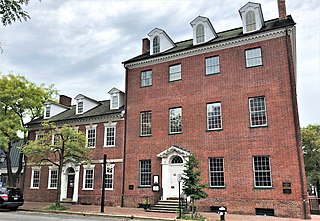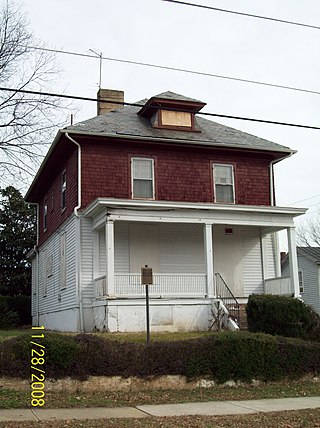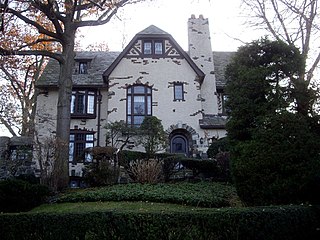
Gadsby's Tavern is a complex of historic buildings at 134 and 138 North Royal Street at the corner of Cameron Street in the Old Town district of Alexandria, Virginia. The complex includes a c.1785 tavern, the 1792 City Tavern and Hotel, and an 1878 hotel addition. The taverns were a central part of the social, economic, political, and educational life of the city of Alexandria at the time. Currently, the complex is home to Gadsby's Tavern Restaurant, American Legion Post 24, and Gadsby's Tavern Museum, a cultural history museum. The museum houses exhibits of early American life in Virginia, and the restaurant operates in the original 1792 City Tavern dining room, serving a mixture of period and modern foods.

Anne Bethel Spencer was an American poet, teacher, civil rights activist, librarian, and gardener. She was a prominent figure of the Harlem Renaissance, also known as the New Negro Movement, despite living in Virginia for most of her life, far from the center of the movement in New York. She met Edward Spencer while attending Virginia Seminary in Lynchburg, Virginia. Following their marriage in 1901, the couple moved into a house he builtArchived 2020-11-30 at the Wayback Machine at 1313 Pierce Street, where they raised a family and lived for the remainder of their lives.

Oatlands Historic House and Gardens is an estate located in Leesburg, Virginia, United States. Oatlands is operated by the National Trust for Historic Preservation and is listed on the National Register of Historic Places as a National Historic Landmark. The Oatlands property is composed of the main mansion and 415 acres of farmland and gardens. The house is judged one of the finest Federal period country estate houses in the nation.

Kenmore, also known as Kenmore Plantation, is a plantation house at 1201 Washington Avenue in Fredericksburg, Virginia. Built in the 1770s, it was the home of Fielding and Betty Washington Lewis and is the only surviving structure from the 1,300-acre (530 ha) Kenmore plantation.

Dr. Robert Walter Johnson House and Tennis Court is a historic home and tennis court in Lynchburg, Virginia, U.S., that was built in 1911 and added to the National Register of Historic Places in 2002. It is located in the Pierce Street Historic District.

The Old City Cemetery is a historic cemetery in Lynchburg, Virginia. It is the oldest municipal (city-owned) cemetery still in use today in the state of Virginia, and one of the oldest such burial grounds in the United States. Since the 1990s it has been operated as a history park and arboretum, in addition to being an active cemetery.

Ralph Johnson Bunche House, the last home of American diplomat Ralph Bunche (1903–1971), is a National Historic Landmark in New York City. It is a single-family home built in 1927 in the neo-Tudor style, and is located at 115–24 Grosvenor Road, Kew Gardens, Queens. It is named after Ralph Bunche, who helped to found the United Nations in 1945. In 1950, he became the first African American and first person of color to win the Nobel Peace Prize, for mediating armistice agreements between Israel and its neighboring countries.

Bremo, also known as Bremo Plantation or Bremo Historic District, is a plantation estate covering over 1,500 acres (610 ha) on the west side of Bremo Bluff in Fluvanna County, Virginia. The plantation includes three separate estates, all created in the 19th century by the planter, soldier, and reformer John Hartwell Cocke on his family's 1725 land grant. The large neo-palladian mansion at "Upper" Bremo was designed by Cocke in consultation with John Neilson, a master joiner for Thomas Jefferson's Monticello. The Historic District also includes two smaller residences known as Lower Bremo and Bremo Recess.

The Ellen Glasgow House, also known as the Branch-Glasgow House, is a historic house at 1 West Main Street in Richmond, Virginia. Built in 1841, it is nationally significant as the home of writer Ellen Glasgow (1873–1945) from 1887 until her death. It was declared a National Historic Landmark in 1971.

The Virginia Randolph Cottage, now the Virginia E. Randolph Museum, is a museum at 2200 Mountain Road in Glen Allen, Virginia. The museum is dedicated to the history of Virginia E. Randolph (1874–1958), an African-American vocational educator in the area for 55 years. The building, built in 1937 and housing Randolph's home economics classrooms, was declared a National Historic Landmark in 1974 in recognition of her legacy as a trainer of vocational teachers; her remains are interred on the grounds.

The Rising Sun Tavern is a historic building in Fredericksburg, Virginia. It was built in about 1760 as a home by Charles Washington, youngest brother of George Washington, and became a tavern in 1792.

Jones Memorial Library is a specialized genealogy and history research library located at 2311 Memorial Avenue in Lynchburg, Virginia.

Point of Honor is an historic home, now a city museum, located in Lynchburg, Virginia. The property has commanding views of the city and the James River. Its name originated due to the land on which it is built being used as a clandestine dueling ground.

First Baptist Church is a historic Baptist church located at 1100 Court Street, Lynchburg, Virginia. It is built of hard-pressed red brick on a rough granite foundation. The main facade of the church, facing Eleventh Street, and the two sides are centered with large rose windows framed within Gothic arches covered with hood moldings. Construction began in 1884 and the church was dedicated in 1886. In the 1920s, Lynchburg architect Stanhope S. Johnson designed the complementary Sunday School annex. In 1941, the interior of the sanctuary was modified by Stanhope S. Johnson, with the creation of a divided chancel. It is home to the oldest Baptist congregation of Lynchburg, established in July 1815. Current as of 2020, First Baptist Church is affiliated with the Cooperative Baptist Fellowship (CBF).

St. Paul's Church is a historic Episcopal church in Lynchburg, Virginia, United States.

Eyre Hall is a plantation house located in Northampton, Virginia, close to Cheriton, and owned by the Eyre family since 1668. The property is one of the state's best preserved colonial homes with gardens among the oldest in the United States. The plantation was placed on the National Register on November 12, 1969. It was designated a National Historic Landmark on March 2, 2012.

Crossroads Tavern, also known as Crossroads Inn, is a historic inn and tavern located at North Garden, Albemarle County, Virginia. It was built about 1820. In the mid nineteenth century, Clifton G. Sutherland, son of Joseph Sutherland, owned and ran the tavern which was located on the Staunton and James River Turnpike. It served as a tavern and overnight lodging for farmers and travelers using the turnpike. In 1889, Daniel B. Landes bought the land at the public auction of the estate of Clifton Sutherland. The property continued to be conveyed to various owners over the years. The Crossroads Tavern is an early nineteenth century two- to three-story, three-bay, double pile brick structure. The building sits on top of a brick and stone foundation, is roofed with tin and has pairs of interior brick chimneys on either gable end. The brick is laid in five course American bond with Flemish variant. Windows on the basement level at the rear of the house are barred; other basement windows are nine-over-six sash. Put-holes are found at the west end of the building, formerly providing sockets for scaffold boards should repairs be necessary. The front facade is dominated by a porch on the second story extending the entire width of the south and east facades. It is supported by five rounded brick columns and the tin roof above is supported by simple square wooden pillars connected by horizontal rails. Doors of the front of the basement level open respectively into kitchen and dining room and into a spirits cellar with its original barrel racks as well as a laundry fireplace. Floors on this level were originally dirt but dining room and kitchen floors have been cemented. The main entrance door on the second level, with its multi-panes lights, opens onto a central stair hall with two main rooms on either side. This stair hall has an ascending stair at its front and both ascending and descending stairs toward its center. Formerly the ascending stairs led to upstairs areas which did not connect. There is no ridge pole in the three attic rooms. The interiors of windows and doors on the main entrance side have extremely long wooden lintels. With few exceptions, the interior woodwork is original, including floors, chair rails, mantels and built in cupboards. Also on the property is a two-story contributing summer kitchen, brick up to the second story and frame above, and with an exterior brick chimney at the rear gable with fireplaces on both floors. It is operated as a bed and breakfast.

Williams–Brown House and Store is a historic home and general store located at Salem, Virginia. It was built about 1837, and is a 2+1⁄2-story, L-shaped brick building with Greek Revival and Federal style design influences. It features a double porch with chamfered edges ending in lambs' tongues.

The Pierce Street Historic District is a residential historic district in Lynchburg, Virginia. The district consists of two blocks of Pierce Street, and one adjoining block each of Fillmore and Buchanan Streets. The area consists of mostly vernacular houses with some Folk Victorian and Craftsman styling. Most of this housing stock was built before 1950.

Ormiston Mansion is a 2+1⁄2-story, red brick, late Georgian period house located in east Fairmount Park, Philadelphia. The house was constructed in 1798 with a large wooden porch in front and a smaller porch in the rear. Many of the original interior features remain including fireplaces with marble mantles and a Scottish bake oven. The cedar shake roof includes a widow's walk and Federal-style dormers, while six large shuttered windows are on each side of the house, and five on the front. The first floor interior includes a large drawing room spanning the entire width of the house, a kitchen, and a dining room with a large door leading to the rear porch. The back of the house overlooks the Schuylkill River.

























